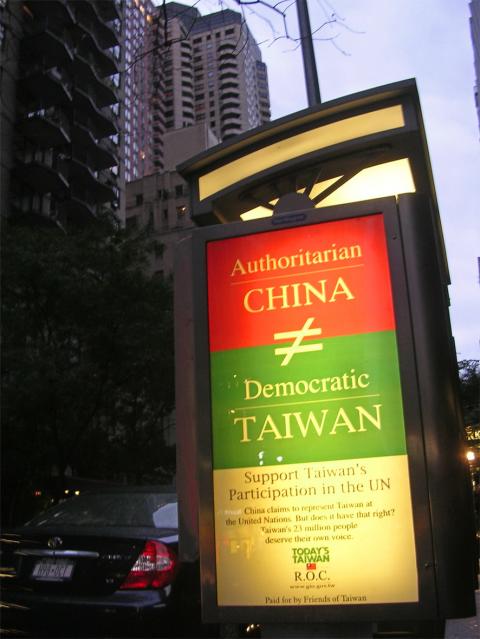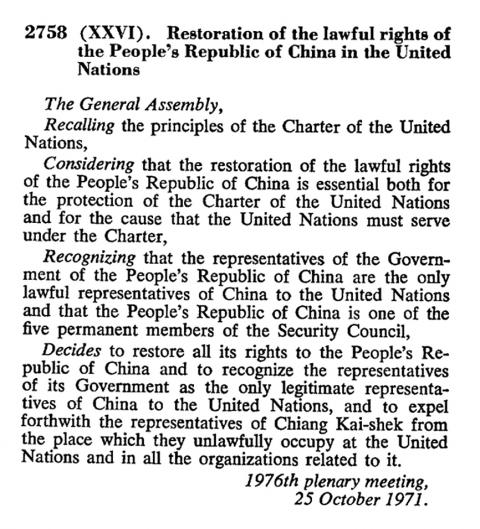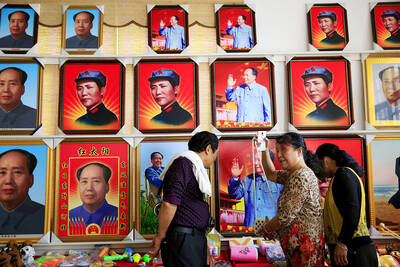Taiwan in Time: Oct.19 to Oct. 25
Taiwan is one of a handful countries in the world not a member of the UN, stemming back to Oct. 25, 1971 when UN General Assembly Resolution 2758 was ratified in a two-thirds vote.
The resolution, sponsored by Albania, recognized the People’s Republic of China (PRC) as “the only legitimate representative of China to the United Nations” and expelled “the representatives of Chiang Kai-shek [蔣介石] from the place which they unlawfully occupy at the United Nations and in all the organizations related to it.”

Photo: Wang Pei
The issue was that after the Chinese Civil War, the PRC under the Chinese Communist Party gained control of China, with Chiang’s Republic of China (ROC) government under the Chinese Nationalist Party (KMT) relegated to Taiwan and other minor islands. Yet both governments continued to claim to be the legitimate ruler of both China and Taiwan.
In fact, the ROC was a charter member of the UN, formed also this week, on Oct. 24, 1945, along with the Soviet Union, the UK and the US.
The UN General Assembly debated transferring China’s seat from the ROC to the PRC throughout the 1950s and 1960s, but the US was able to use its influence to block the move.

Photo courtesy of Wikimedia Commons
As early as 1950, the UK recognized the PRC as the legitimate government of China, severing relations with the ROC. But things really started changing in the 1960s, as the PRC gained the support of a large number of newly independent nations (mostly in Asia, South America and Africa) that changed the composition of the international body. And in 1964, even France, decided to recognize the PRC.
Starting in 1961, the US and other countries would introduce a resolution every year deeming any proposal to change China’s representation an “important question” that required a two-thirds majority to pass. That resolution would pass every time, but the vote for the subsequent resolution regarding accepting the PRC became increasingly tighter, reaching a tie in 1965.
Canada established ties with the PRC in October 1970. A month later, for the first time a majority supported the PRC’s admission with a 51 to 49 vote — although still not meeting the two-thirds requirement.

Photo taken from the book ‘The KMT and The ROC’
The US had tried to propose the idea of dual representation by allowing both governments into the UN (with the PRC taking over the Security Council seat) but neither Chiang nor the PRC would likely have agreed to such an idea due to their insistence on being the sole ruler of China and Taiwan.
The US submitted a dual representation resolution in 1971 nonetheless. Albania, however, had already submitted its bid to admit the PRC and it was to be voted on first. If passed, then dual representation would be a moot point. The Americans made one last effort by proposing to remove the “expulsion of Chiang” part from Albania’s resolution, but the motion was rejected.
Before the vote, the ROC delegation announced that they would not take part in further proceedings and walked out of the General Assembly.

Photo: Wang Yi-sung, Taipei Times
On Oct. 27, Chiang officially declared the ROC’s withdrawal from the UN and its refusal to recognize the resolution.
“The United Nations has set justice aside, shamefully prostrating to evil forces and cowardly yielding to violence,” he wrote. “The United Nations that my country helped form is now a hotbed of evil, and history will prove that the Republic of China’s declaration of withdrawal will also be the declaration of the destruction of the United Nations.”
“My compatriots, the fate of our country is not in the hands of the United Nations, but in our own,” he added.
The resolution never directly mentioned the ROC or Taiwan, but the country’s bid for membership starting in the 1990s under variations of “Republic of China, Taiwan” and in 2007 as “Taiwan.”
It has continuously been rejected largely because of China’s opposition and claim that Taiwan is part of its territory and not a sovereign country.
In 2008, President Ma Ying-jeou (馬英九) stopped applying as part of his “diplomatic truce” policy toward China, but Taiwanese-Americans continue to protest outside the UN Headquarters in New York each year.
Taiwan in Time, a column about Taiwan’s history that is published every Sunday, spotlights important or interesting events around the nation that have anniversaries this week.

Taiwan can often feel woefully behind on global trends, from fashion to food, and influences can sometimes feel like the last on the metaphorical bandwagon. In the West, suddenly every burger is being smashed and honey has become “hot” and we’re all drinking orange wine. But it took a good while for a smash burger in Taipei to come across my radar. For the uninitiated, a smash burger is, well, a normal burger patty but smashed flat. Originally, I didn’t understand. Surely the best part of a burger is the thick patty with all the juiciness of the beef, the

The ultimate goal of the Chinese Communist Party (CCP) is the total and overwhelming domination of everything within the sphere of what it considers China and deems as theirs. All decision-making by the CCP must be understood through that lens. Any decision made is to entrench — or ideally expand that power. They are fiercely hostile to anything that weakens or compromises their control of “China.” By design, they will stop at nothing to ensure that there is no distinction between the CCP and the Chinese nation, people, culture, civilization, religion, economy, property, military or government — they are all subsidiary

Nov.10 to Nov.16 As he moved a large stone that had fallen from a truck near his field, 65-year-old Lin Yuan (林淵) felt a sudden urge. He fetched his tools and began to carve. The recently retired farmer had been feeling restless after a lifetime of hard labor in Yuchi Township (魚池), Nantou County. His first piece, Stone Fairy Maiden (石仙姑), completed in 1977, was reportedly a representation of his late wife. This version of how Lin began his late-life art career is recorded in Nantou County historian Teng Hsiang-yang’s (鄧相揚) 2009 biography of him. His expressive work eventually caught the attention

This year’s Miss Universe in Thailand has been marred by ugly drama, with allegations of an insult to a beauty queen’s intellect, a walkout by pageant contestants and a tearful tantrum by the host. More than 120 women from across the world have gathered in Thailand, vying to be crowned Miss Universe in a contest considered one of the “big four” of global beauty pageants. But the runup has been dominated by the off-stage antics of the coiffed contestants and their Thai hosts, escalating into a feminist firestorm drawing the attention of Mexico’s president. On Tuesday, Mexican delegate Fatima Bosch staged a